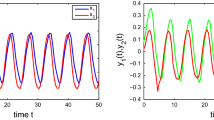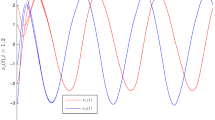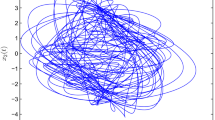Abstract
This paper addresses the passivity problem for delayed non-autonomous discrete-time inertial neural networks (NDINN), including the discrete-time switched inertial neural networks (DSINN) with state-dependent discontinuous right-hand side as its special case. First, we take a linear transformation to transform the original network into first-order difference equations. Second, by utilizing the Lyapunov direct method and with the help of the property of maximum singular value, we present a passivity criterion for the NDINN with delay-dependent linear matrix inequalities. Combining with the characteristic function method, the proposed analytical approach for NDINN is further extended to the DSINN. Finally, two simulation examples validate the efficacy of the analytical results.





Similar content being viewed by others
References
Wang J, Jiang H, Ma T, Hu C (2018) Delay-dependent dynamical analysis of complex-valued memristive neural networks: continuous-time and discrete-time cases. Neural Netw 101:33–46
Ding S, Wang Z, Zhang H (2018) Dissipativity analysis for stochastic memristive neural networks with time-varying delays: a discrete-time case. IEEE Trans Neural Netw Learn Syst 29:618–630
Harrer H, Nossek J (1992) Discrete-time cellular neural networks. Int J Circuit Theory Appl 20:453–467
Shen T, Petersen L (2016) Linear threshold discrete-time recurrent neural networks: stability and globally attractive sets. IEEE Trans Autom Control 61:2650–2656
Sowmiya C, Raja R, Cao J, Li X, Rajchakit G (2018) Discrete-time stochastic impulsive BAM neural networks with leakage and mixed time delays: An exponential stability problem. J Franklin Inst 355:4404–4435
Liu H, Wang Z, Shen B, Huang T, Alsaadi F (2018) Stability analysis for discrete-time stochastic memristive neural networks with both leakage and probabilistic delays. Neural Netw 102:1–9
Ma Z, Sun G, Liu D, Xing X (2016) Dissipativity analysis for discrete-time fuzzy neural networks with leakage and time-varying delays. Neurocomputing 175:579–584
Song Q, Zhao Z, Liu Y (2015) Impulsive effects on stability of discrete-time complex-valued neural networks with both discrete and distributed time-varying delays. Neurocomputing 168:1044–1050
Ping Z, Hu H, Huang Y, Ge S, Lu J (2018) Discrete-time neural network approach for tracking control of spherical inverted pendulum. IEEE Trans Syst Man Cybern Syst. https://doi.org/10.1109/TSMC.2018.2834560
Rubio J (2018) Discrete time control based in neural networks for pendulums. Appl Soft Comput 68:821–832
Hien L, Son D, Trinh H (2018) On global dissipativity of nonautonomous neural networks with multiple proportional delays. IEEE Trans Neural Netw Learn Syst 29:225–231
Wang L, Shen Y, Zhang G (2016) Synchronization of a class of switched neural networks with time-varying delays via nonlinear feedback control. IEEE Trans Cybern 46:2300–2310
Wang H, Liu Z, He Y (2019) Exponential stability criterion of the switched neural networks with time-varying delay. Neurocomputing 331:1–9
Wei X, Zhou D, Zhang Q (2009) On asymptotic stability of discrete-time non-autonomous delayed Hopfield neural networks. Comput Math Appl 57:1938–1942
Huang Z, Mohamod S, Bin H (2010) Multiperiodicity analysis and numerical simulation of discrete-time transiently chaotic non-autonomous neural networks with time-varying delays. Commun Nonlinear Sci Numer Simulat 15:1348–1357
Zou L, Zhou Z (2006) Periodic solutions for nonautonomous discrete-time neural networks. Appl Math Lett 19:174–185
Mauro A, Conti F, Dodge F, Schor R (1970) Subthreshold behavior and phenomenological impedance of the squid giant axon. J Gen Physiol 55:497–523
Ashmore J, Attwell D (1985) Models for electrical tuning in hair cells. Proc R Soc Lond B 226:325–344
Angelaki D, Correia M (1991) Models of membrane resonance in pigeon semicircular canal type II hair cells. Biol Cybern 65:1–10
Koch C (1984) Cable theory in neurons with active, linearized membranes. Biol Cybern 50:15–33
Babcock K, Westervelt R (1986) Stability and dynamics of simple electronic neural networks with added inertial. Phys D 23:464–469
Wheeler D, Schieve W (1997) Stability and chaos in an inertial two-neuron system. Phys D 105:267–284
Li C, Chen G, Liao X, Yu J (2004) Hopf bifurcation and chaos in a single inertial neuron model with time delay. Eur Phys J B 41:337–343
Ge J, Xu J (2013) Hopf bifurcation and chaos in an inertial neuron system with coupled delay. Sci China Technol Sci 56:2299–2309
Wang J, Tian L (2017) Global Lagrange stability for inertial neural networks with mixed time varying delays. Neurocomputing 235:140–146
Zhang G, Zeng Z (2018) Exponential stability for a class of memristive neural networks with mixed time-varying delays. Appl Math Comput 321:544–554
Tu Z, Cao J, Hayat T (2016) Global exponential stability in lagrange sense for inertial neural networks with time-varying delays. Neurocomputing 171:524–531
Tu Z, Cao J, Hayat T (2016) Matrix measure based dissipativity analysis for inertial delayed uncertain neural networks. Neural Netw 75:47–55
Rakkiyappan R, UdhayaKumari E, Chandrasekar A, Krishnasamy R (2016) Synchronization and periodicity of coupled inertial memristive neural networks with supremums. Neurocomputing 214:739–749
Li X, Li X, Hu C (2017) Some new results on stability and synchronization for delayed inertial neural networks based on non-reduced order method. Neural Netw 96:91–100
Xiao Q, Huang T, Zeng Z (2019) Global exponential stability and synchronization for discrete-Time inertial neural networks with time delays: a timescale approach. IEEE Trans Neural Netw Learn Syst 30:1854–1866
Willems J (1972) Dissipative dynamical systemspart I: general theory. Arch Rational Mech Anal 45:321–351
Willems J (1972) Dissipative dynamical systemspart II: linear systems with quadratic supply rates. Arch Rational Mech Anal 45:352–393
Ding K, Zhu Q, Liu L (2019) Extended dissipativity stabilization and synchronization of uncertain stochastic reaction–diffusion neural networks via intermittent non-fragile control. J Frankl Inst 356:11690–11715
Zhu Q, Kumar S, Raja R, Rihan F (2019) Extended dissipative analysis for aircraft flight control systems with random nonlinear actuator fault via non-fragile sampled-data control. J Frankl Inst 356:8610–8624
Zhu Q, Saravanakumar T, Gomathi S, Anthoni S (2019) Finite-time extended dissipative based optimal guaranteed cost resilient control for switched neutral systems with stochastic actuator failures. IEEE Access 7:90289–90303
Xiao Q, Huang Z, Zeng Z (2019) Passivity analysis for memristor-based inertial neural networks with discrete and distributed delays. IEEE Trans Syst Man Cybern Syst 49:375–385
Wan P, Jian J (2018) Passivity analysis of memristor-based impulsive inertial neural networks with time-varying delays. ISA Trans 74:88–98
Xiao Q, Huang T, Zeng Z (2018) Passivity and passification of fuzzy memristive inertial neural networks on time scales. IEEE Trans Fuzzy Syst 26:3342–3355
Rakkiyappan R, Chandrasekar A, Cao J (2015) Passivity and passification of memristor-based recurrent neural networks with additive time-varying delays. IEEE Trans Neural Netw Learn Syst 26:2043–2057
Guo Z, Wang J, Yan Z (2014) Passivity and passification of memristor-based recurrent neural networks with time-varying delays. IEEE Trans Neural Netw Learn Syst 25:2099–2109
Zhu J, Zhang Q, Yuan Z (2010) Delay-dependent passivity criterion for discrete-time delayed standard neural network model. Neurocomputing 73:1384–1393
Zhu X, Yang G (2008) Jensen inequality approach to stability analysis of discrete-time systems with time-varying delay. In: American control conference, pp 1644–1649
Chen J, Lu J, Xu S (2016) Summation inequality and its application to stability analysis for time-delay systems. IET Control Theory Appl 10:391–395
Xiong L, Cheng J, Cao J, Liu Z (2018) Novel inequality with application to improve the stability criterion for dynamical systems with two additive time-varying delays. Appl Math Comput 321:672–688
Zhang H, Qiu Z, Xiong L, Jiang G (2019) Stochastic stability analysis for neutral-type Markov jump neural networks with additive time-varying delays via a new reciprocally convex combination inequality. Int J Syst Sci 50:1–19
Wu T, Xiong L, Cao J, Liu Z, Zhang H (2018) New stability and stabilization conditions for stochastic neural networks of neutral type with Markovian jumping parameters. J Franklin Inst 355:8462–8483
Zhu Q, Yang X, Wang H (2010) Stochastically asymptotic stability of delayed recurrent neural networks with both Markovian jump parameters and nonlinear disturbances. J Franklin Inst 347:1489–1510
Zhu Q (2019) Stabilization of stochastic nonlinear delay systems with exogenous disturbances and the event-triggered feedback control. IEEE Trans Autom Control 64:3764–3771
Zhu Q, Wang H (2018) Output feedback stabilization of stochastic feedforward systems with unknown control coefficients and unknown output function. Automatica 87:166–175
Author information
Authors and Affiliations
Corresponding author
Additional information
Publisher's Note
Springer Nature remains neutral with regard to jurisdictional claims in published maps and institutional affiliations.
This work is supported by the National Natural Science Foundation of China (61873219) .
Rights and permissions
About this article
Cite this article
Chen, X., Lin, D. Passivity Analysis of Non-autonomous Discrete-Time Inertial Neural Networks with Time-Varying Delays. Neural Process Lett 51, 2929–2944 (2020). https://doi.org/10.1007/s11063-020-10235-6
Published:
Issue Date:
DOI: https://doi.org/10.1007/s11063-020-10235-6




